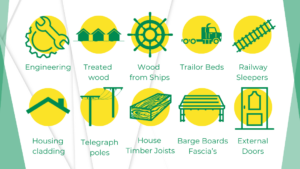What are the Wood Waste Regulation Changes?
Are you concerned about the recent changes in regulations for wood waste? We have received an increase of enquiries about the new regulations and what implications they may have on our customers. In this post, we will explain the new regulations that have come into place and how they will affect your business.
The Environment Agency (EA) has confirmed the withdrawal of the Regulatory Position Statement (RPS) 250 effective from 1st September 2023. This decision will lead to changes in waste wood handling regulations from the construction and demolition (C&D) industry.
This regulatory position statement (RPS) applies to hazardous waste wood removed from domestic premises, demolition sites and other business premises and undertakings. It allows operators with an existing environmental permit to:
- store hazardous waste wood at a waste transfer station
- process and mix hazardous waste wood with non-hazardous waste wood at a wood processing site
This RPS took effect on 1 August 2021. The Environment Agency will withdraw it by 1 September 2023.

The RPS will give waste wood storage and processing businesses time to do both of the following:
- understand the quantities and types of hazardous waste wood arising from demolition and refurbishment activities
- apply for a permit variation to accept hazardous waste wood if there is a market and business need
What types of wood waste now classify as hazardous waste?
- Barge boards
- External fascia
- Soffit boards
- External joinery
- External doors
- Roof timber
- Tiling cladding
- Tiling battens
- Timber frames
- Timber joists
There are now 4 grades of wood waste that include; hazardous, non-hazardous, or potentially hazardous:
- Grade A – the cleanest wood type that is not hazardous waste and includes the likes of pallets, packaging crates, and joinery offcuts.
- Grade B and C – may contain potentially hazardous wood so might require testing before disposal. This can include furniture, wooden fittings, and chipboard.
- Grade D – is always classed as hazardous waste and can include wood types found in fencing, railway sleepers, and cooling towers.
If you would like to speak to a member of our Team of experts on this subject, or are worried about these changes. Get in touch and we are always happy to help.
Give us a call on 01666 505800.